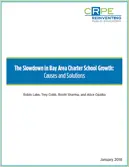Read the executive summary.
Read the article in Education Next.
Read the full report.
Why Is Charter Growth Slowing? Lessons From the Bay Area
Since 2013, charter school growth has slowed significantly across the country, and the trend is similar in the San Francisco Bay Area. In fact, the 2016-2017 school year marked the first time in at least 10 years when more Bay Area charter schools closed than opened.
Three reasons for the slowdown
Our research has revealed three interlocking factors contributing to slower charter school growth:
- Too few school facilities that new schools can afford.
- Increased competition for resources from well-established charter networks and schools.
- Political opposition from districts, some of which block access to facilities, bring lawsuits against growing schools, or make charters’ compliance with state regulations more difficult.
Reinvigorating high-quality charter school growth
To respond to the demand and need for more high-quality schools in the Bay Area, we recommend the following paths forward:
- Pursue revisions to Proposition 39.
- Offer “consolidation grants” to districts that will use their space to maximum efficiency.
- Require that districts that fail to reduce costs responsibly leave the property ownership business.
- Target more viable counties for growth.
- Cultivate a more diverse supply of charter school operators.
- Negotiate district-charter-state “grand bargains” to give charters access to new buildings.
In cities across the country, charters and districts can learn from successful models and work collaboratively to encourage the growth of high-quality schools that serve all students.





